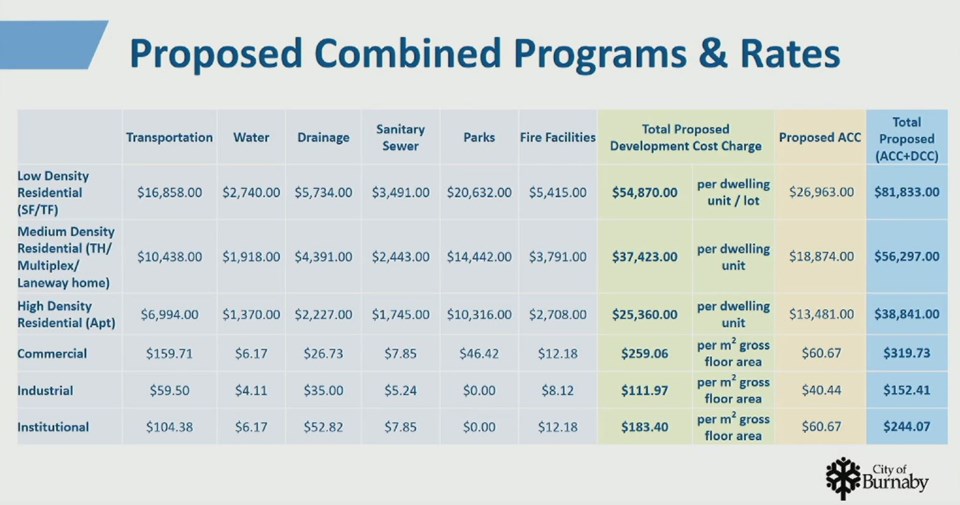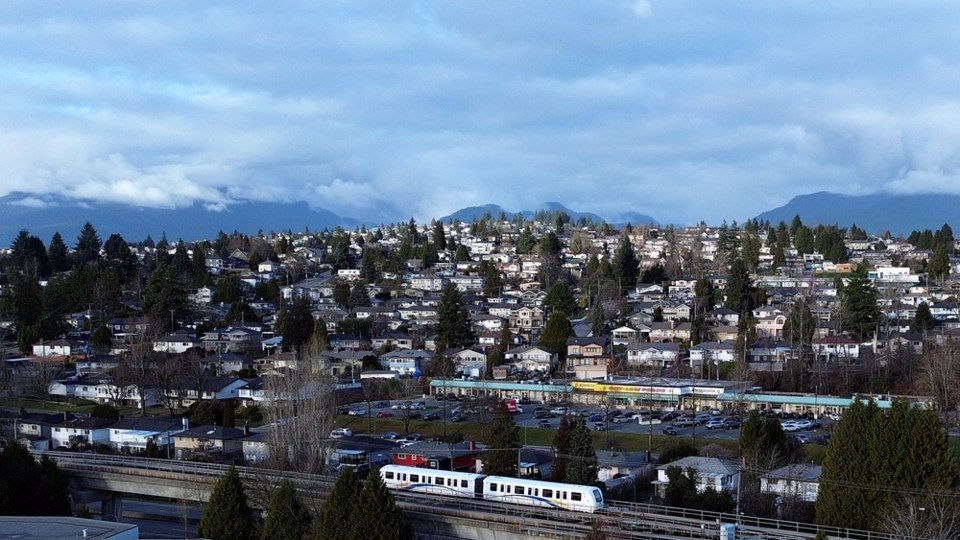Big changes are coming to B.C.’s housing landscape with new provincial legislation, and cities are tasked with calculating how to pay for the increased growth.
Burnaby staff said they’ve crammed 24 months of planning into just three to get the city prepared for new housing rules, which will allow four to six homes on previously single- and two-family lots, as well as much taller minimum allowable heights near SkyTrain stations.
The changes mean that cities will need new funding tools to pay for things like the pipes, roads and community centres needed to support the new homes.
Mayor Mike Hurley has said the needed infrastructure improvements alone could cost $1 million per 100 metres.
The province's solution is updated and new charges cities will levy on developers to pay for growth-related infrastructure and amenities.
They’re called development cost charges (DCCs) and amenity cost charges (ACCs).
Burnaby city council approved those new rates at its meeting March 25, after three council sessions between January and March with consultants from Urban Systems explaining the financing tools.
What are DCCs and ACCs?
While ACCs are a new charge the province has created, DCCs have been commonly used throughout B.C. communities, according to Urban Systems.
DCCs help provide certainty for developers to plan the costs of development.
But Burnaby’s DCC program has historically been limited, and the city’s general manager of planning and development said the usual way of business will be “severely impacted” by the provincial changes.
“We’re starting from a deep deficit,” said Ed Kozak, planning general manager. “Burnaby doesn’t have a rich or strong tradition of using these funding tools. Other municipalities do, so we’re starting from, I don’t know, a negative-20 position or so.”
There are two underlying principles at play when it comes to who pays for growth, Kozak said.
One is that growth pays for growth; the other is that charging for growth must not inhibit development or future growth.
It means ACCs and DCCs can only be used for “growth components of infrastructure” – that is, they can’t be charged for replacing like-for-like facilities (although if the facilities are replaced and expanded, there are other calculations that can be done to follow the growth-pays-for-growth principle).
DCCs are collected for the hard costs of infrastructure projects that must be funded to support growth, ranging from sidewalks and bike paths to major storm sewers, water mains, fire halls, police stations and recycling facilities.
DCCs defined: DCCs are charges levied on development to help pay for the costs of transportation and utility infrastructure, fire, police and solid waste facilities; and parkland acquisition and development, to meet the needs of growth:
Examples: Roads, water, sewer, drainage infrastructure, police halls, fire halls, recycling facilities and parks
DCCs can be collected for parkland acquisition as well, but the consultants noted some projects like dog parks, spray parks and sports fields may be ineligible – though that’s where ACCs could come in.
That’s because ACCs are collected for amenity projects like community centres and libraries.
ACCs defined: ACCs are charges levied on development to help pay for the costs of facilities or features that provide social, cultural, heritage, recreational or environmental benefits to a community, including (without limitation):
Examples: Community, youth or seniors’ centres; recreation or athletic facilities; libraries; daycare facilities; public squares
ACCs will help fund part of Burnaby’s revenue that will be lost from “density bonusing,” another term for the city’s community benefit bonus program that allows developers to voluntarily pay cash in exchange for being allowed to build more, denser housing.
Because the province is requiring cities to allow taller buildings near SkyTrain stations, the city has less density to sell.
Burnaby has collected more than $670 million in density bonusing dollars in the last five years, and that money goes toward community amenities like the Burnaby Lake Recreation Centre and Fire Stations 4 and 8, as well as affordable housing projects.
(Affordable housing is not mentioned as something ACCs can fund, meaning the city’s density bonusing tool would be an appropriate funding tool, according to the consultants.)
Kozak said the density bonus charges cost more on a per unit basis than the ACCs, but he noted the charges vary based on location and type of development.
He said density bonus charges are voluntarily chosen by developers, while ACCs and DCCs will be mandatory.
Kozak also noted the city must be “extremely careful” about “double dipping” – that is, a city can’t charge for the same project twice using different funding tools.
What are Burnaby’s new charges?
The new charges are as follows:
For ACCs:
- High-density (apartment) per unit: $13,481
- Medium-density (townhouse) per unit: $18,874
- Low density (single-family/two-family) per unit: $26,963
For DCCs:
- High-density (apartment) per unit: $25,360
- Medium-density (townhouse) per unit: $37,423
- Low density (single-family/two-family) per unit: $54,870
There are also DCCs and ACCs charged on a per metre squared basis for commercial, industrial and institutional development.

Burnaby approved the 182 infrastructure projects to be funded through DCCs for transportation, water, drainage, sewer, parkland acquisition and improvements and fire protection.
The amenity projects that have been approved by council for funding through ACCs are the Metrotown library expansion, Confederation Park Community Centre, Bonsor Recreation Complex redevelopment, and two unspecified childcare facilities.
The lists can be updated as projects complete.
The DCCs are calculated based on a variety of factors set by the province including: what kind of projects can be included, the growth time period (Burnaby’s is 25 years), how much a project benefits growth as opposed to existing population (called the “benefit allocation”), land use, how much the city chips in for a growth-related project (the “municipal assist factor,” Burnaby council approved the factor at one per cent).
Council could consider a higher municipal assist factor, which would lower the cost of the DCC, but Urban Systems noted it would place a greater burden on existing residents.
The new rates are expected to be effective July 1.
For more information on ACCs and DCCs, see the province’s best practices guide for DCCs, the province’s website on development financing and the city’s website.





